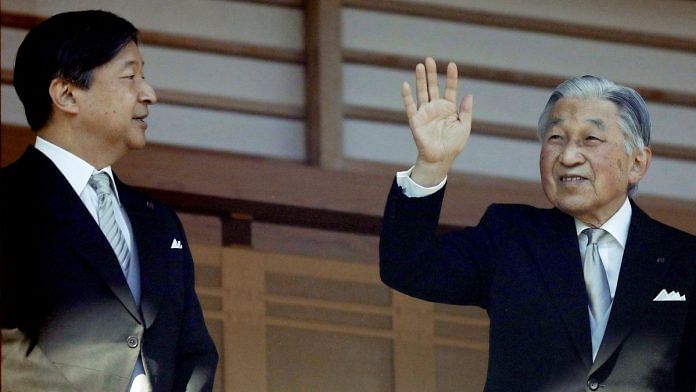Tokyo: Japanese Emperor Akihito will end his three-decade reign on Tuesday, voluntarily stepping down due to health concerns to make way for his son in the country’s first abdication of the Chrysanthemum Throne since 1817.
His 31-year imperial era known as Heisei, which can be translated as “achieving peace,” will come to an end with a ceremony attended by about 300 political leaders and dignitaries starting at about 5 p.m. local time at the Imperial Palace in Tokyo. The next morning, his son, Crown Prince Naruhito, 59, will ascend the throne in ceremonies also at the palace.
Akihito, 85, helped modernize the world’s oldest hereditary monarchy. He was the first Japanese emperor to marry a commoner — Empress Michiko — and the first to reign entirely under the U.S.-drafted postwar, pacifist constitution that made the role strictly symbolic.
His unprecedented apologies for the wartime aggression launched in the name of his father, Hirohito — posthumously named the Emperor Showa — helped ease often fraught relations with neighbors China and South Korea, which bore heavy blows from Japan’s militarism. Akihito spoke in ordinary Japanese, rather than the formal grammar employed by his father, the last emperor regarded by prevailing custom to be a living deity.
His Heisei era started in 1989 when Japan was an economic juggernaut, its companies seemed unstoppable and its products flooded global markets. But the asset-inflated bubble economy came crashing down from 1991 and about 20 years after that, Japan’s once-impoverished neighbor China overtook it as the world’s second-largest economy.
Japan became the developed world’s fastest-aging country during his reign and it managed disasters that included the 1995 earthquake that devastated the Kobe area and the 2011 earthquake and tsunami that hit the northeast coast, leaving about 20,000 people dead or missing. Akihito and his wife Michiko visited survivors at shelters and were seen by many in Japan as helping a battered nation recover through their compassion.
With public criticism of the emperor seen as a taboo and his public words often restricted to carefully prepared texts, Akihito has largely been shielded from scandal.
Japan has set aside some 16.6 billion yen ($149 million) for months of ceremonies related to the change of emperor, the Nikkei newspaper reported in December, and extended its “Golden Week” spring holiday to 10 days. There’s been a flood of TV programming taking sentimental journeys through the Heisei years, counting down its best songs and recapping its history.
The nattily dressed Akihito has spent the last few weeks of his reign touring the country with Michiko, waving to crowds and performing rituals at shrines to symbolically inform his ancestors that he is stepping down. His health concerns included prostate surgery in 2003 and heart bypass surgery in 2012.
In 2016, Akihito told the public he may no longer be physically fit enough to carry out his duties. This set the stage for parliament to pass a one-time law about a year later allowing abdication, with a special panel then setting April 30, 2019, as the end of his imperial era. The last emperor to abdicate was Kokaku, who stepped two centuries ago down to make way for his son.
In retirement, Akihito will take the title emperor emeritus and move into a smaller imperial residence with Michiko, who he first met on a tennis court more than 60 years ago.
But there will be no parade, for now, to welcome the new emperor. That will come on Oct. 22, which will also be a national holiday.



